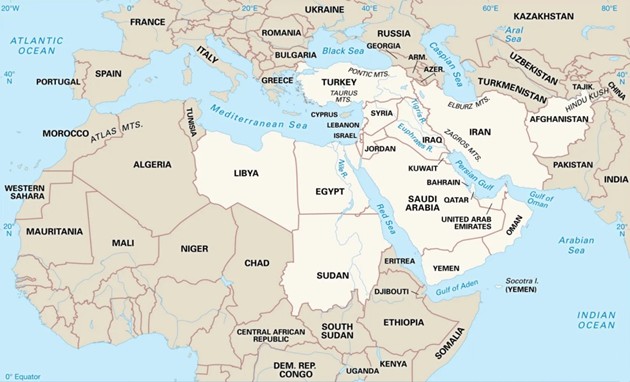Trump’s Middle East Strategy: Sanctions, Syria, and Shifting Alliances
Trump’s Middle East Strategy: Sanctions, Syria, and Shifting Alliances
Syllabus:
GS-2:
Bilateral Groupings & Agreements , Groupings & Agreements Involving India and/or Affecting India’s Interests , Effect of Policies & Politics of Countries on India’s Interests , International Treaties & Agreements
Focus:
U.S. President Donald Trump recently met Ahmad al-Sharaa, Syria’s new de facto leader and former Al-Qaeda figure, in Riyadh. In a surprising turn, he announced plans to lift decades-old sanctions on Syria, signaling a major strategic shift in U.S. Middle East policy. This marks a new phase in American regional engagement, with implications for Israel, Iran, and Gulf States.
Background and Recent Developments:
Trump’s Middle East Tour and Syria Meeting
- Trump visited Saudi Arabia, Qatar, and the UAE, reaffirming U.S. ties.
- Announced sanctions relief for Syria to give the nation “a chance at greatness.”
- Held a historic meeting with Syria’s Ahmad al-Sharaa, alongside Mohammed bin Salman and virtually with Recep Tayyip Erdoğan.
Who is Ahmad al-Sharaa?
- Formerly known as Abu Muhammad al-Golani, a senior Al-Qaeda leader.
- In 2017, the U.S. placed a bounty on him for his role in terror attacks.
- Recently ousted Bashar al-Assad and assumed power in Syria.
Sanctions and the U.S.-Syria Relationship:
History of U.S. Sanctions on Syria
- Started in 1979 due to Syria’s support for anti-Israel groups.
- Strengthened in 2004 and again in 2011 following Assad’s human rights abuses.
- The Caesar Act (2019) enforced sanctions on entities committing rights violations.
Sanctions Relief and Rationale
- Trump aims to revoke sanctions through executive action and Congress.
- Assad’s removal serves as a trigger to remove restrictions linked to his regime.
- Lifting sanctions seen as vital for Syria’s $800 billion post-war reconstruction.
Strategic and Political Considerations:
Domestic and Regional Calculations
- Al-Sharaa’s regime appears more moderate and inclusive.
- United Syria and integrated militias help create a stable internal environment.
-
Gulf countries, especially Qatar and Turkey, back Al-Sharaa’s rise.
Trump’s Regional Strategy
- Prefers regional ownership of conflict resolution.
- Wants reduced American military presence in Syria and Iraq.
-
No direct U.S. economic support pledged, but regional actors are investing.
Geopolitical Trade-Offs
- Al-Sharaa expected to join Abraham Accords, recognize Israel, remove foreign militants.
-
S. insists Syria help in countering ISIS and manage detention centers.
Economic and Trade Motivations:
Economic Interests Driving Policy
- Trump’s strategy emphasizes trade over ideology.
- Seeks economic deals with Gulf nations over prolonged military involvement.
- Signed deals worth:
- $600 billion with Saudi Arabia,
- $243.5 billion with Qatar,
-
$200 billion with UAE.
Private and Personal Deals
- Qatar offered Trump a Boeing 747-8 and will host Trump-branded real estate.
- Saudi’s Vision 2030 aligns with Trump allies like Elon Musk.
- Emphasis on technology and real estate boosts S.-Gulf economic integration.
Implications for U.S., Israel, and Iran:
Tensions with Israel
- Israel opposes sanctions relief for Syria and increased U.S.-Turkey ties.
- Despite Israeli objections, U.S. approved a $304 million missile deal with Turkey.
-
Working to restore Turkey’s participation in the F-35 program.
Approach to Iran
- S. may be nearing a nuclear deal with Iran.
- Iran might surrender enriched uranium under its own terms.
- The Houthi militia, backed by Iran, is a key bargaining tool in negotiations.
Israel’s Strategic Concerns
- Houthis may not stop attacks on Israel despite U.S.-Iran détente.
- Israel warns it will defend itself unilaterally if necessary.
Conclusion:
Trump’s Middle East pivot marks a shift from ideological commitments to pragmatic deal-making. Sanctions relief for Syria, once unthinkable due to terror links, highlights a transactional approach prioritizing trade, regional stability, and reduced U.S. military entanglements. This reordering of alliances poses new challenges for Israel, recalibrates Iran’s leverage, and redefines America’s Middle East role.
Source: IE
Mains Practice Question:
Critically examine the implications of the U.S. lifting sanctions on Syria under Trump’s administration. How does this align with evolving American interests in the Middle East, and what are its potential consequences for regional powers like Israel, Iran, and Gulf states?




